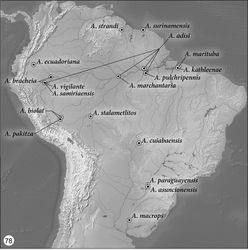Asklepia pulchripennis
| Notice: | This page is derived from the original publication listed below, whose author(s) should always be credited. Further contributors may edit and improve the content of this page and, consequently, need to be credited as well (see page history). Any assessment of factual correctness requires a careful review of the original article as well as of subsequent contributions.
If you are uncertain whether your planned contribution is correct or not, we suggest that you use the associated discussion page instead of editing the page directly. This page should be cited as follows (rationale):
Citation formats to copy and paste
BibTeX: @article{Erwin2014ZooKeys430, RIS/ Endnote: TY - JOUR Wikipedia/ Citizendium: <ref name="Erwin2014ZooKeys430">{{Citation See also the citation download page at the journal. |
Ordo: Coleoptera
Familia: Carabidae
Genus: Asklepia
Name
Asklepia pulchripennis (Bates) 1871 comb. n. – Wikispecies link – Pensoft Profile
- Eucaerus pulchripennis Bates, 1871:79.
Holotype
Brazil, Pará, Santarém, Rio Tapajos, 2.4079°S, 54.7969°W, 30m, (H.W.Bates) (MNHP: ADP132531, female). Specimen labeled “Holotype” by George E. Ball in 1972.
Derivation of specific epithet
The specific epithet, pulchripennis, is a noun in apposition that adequately describes this species with pretty (pulchri-) patterned elytra (-pennis) contrasted with shiny aurantiacus head and pronotum.
Proposed english vernacular name
Beautiful pattern-wing beetle.
Diagnosis
With the attributes of the genus Asklepia as described by Liebke (1938)[1] and as noted above under the generic diagnosis, and medium-sized for the genus (SBL = 2.718 mm). Adults with head and prothorax fulvous, elytral maculae fuscous; elytron fulvous with a fuscous macula in the basal lateral quadrant barely trespassing proximal quadrant and a fuscous macula in the apical lateral quadrant extending to the upper half of apical proximal quadrant; lower half of basal and medial quadrant’s sutural area fuscous; metasternum, abdominal sterna III-VI, and epipleuron flavous, abdominal sternum VII fuscous; legs testaceous; antennal scape, pedicel, and antennomere 3 testaceous, antennomeres 4-6 deeply infuscated, 7-11 white. Dorsal surface devoid of microsculpture, surface luster very shiny. Pronotum markedly convex with lateral margin effaced except just anterior to hind angle and there a simple bead; anterior angles feebly produced, hind angle slightly prominent, median line markedly defined. Elytral interneurs effaced from the greater part of the elytron surface, only evident as pale coarse punctures in the apical proximal quadrant and with scattered punctures in the medial quadrants, as well as along entire interneurs 1 and 2.
Description
(Habitus, Fig. 50). Size: [See also Table 22] Medium-size for the genus; ABL = 3.019 mm, SBL = 2.718 mm, TW (total width) 1.366 mm, LP = 0.584 mm, WP = 0.700 mm, LE = 1.732 mm. Color: See diagnosis above. Luster: See diagnosis above. Head (Fig. 50): as in description for genus above. Prothorax. Pronotum (Fig. 50) moderately broad, as wide as head across eyes (WH/WP: 1.0987), longer than head (LP/LH: 1.454), about as longer than wide (WP/LP: 1.198); markedly cordiform and convex, lateral margin effaced with seta at anterior third on slightly raised area; apex markedly constricted; anterior angles feebly produced, hind angle slightly produced and setose; median line feebly defined, basal and apical transverse impressions punctate, punctures infuscated; surface smooth throughout. Pterothorax. Normal for genus, see description for genus above. Elytra slightly convex; at apical third twice as wide as head across eyes (WH/TW: 0.563) and pronotum (WP/TW: 0.512), longer than wide. Elytral interneurs effaced from the greater part of the elytron surface, only evident as pale coarse punctures of the apical proximal quadrant and scattered punctures on medial quadrants, as well as along entire interneurs 1 and 2. Hind wings fully developed. Legs. Overall, normal for genus, see description for genus above. Abdominal sterna. Overall, normal for genus, see description for genus above. Male genitalia. Unknown. Female genitalia. Not investigated, presumably similar to that of Asklepia demiti sp. n.
Dispersal potential
These beetles are macropterous and probably capable of flight. They are moderately swift and agile runners.
Distribution
(Fig. 78). This species has been found at only one location on a clear-water system of the middle Amazon River drainage system. But that does not at all indicate its real distribution: as has been pointed out above, very small beetles are inadequately sampled, especially in the Neotropics.
Way of life
See Erwin (1991)[2] for a general description. Bates reported finding the holotype on the shore of the Rio Tapajos, a gravelly clear water tributary of the Rio Amazonas.
Other specimens studied
None.
Taxon Treatment
- Erwin, T; Zamorano, L; 2014: A synopsis of the tribe Lachnophorini, with a new genus of Neotropical distribution and a revision of the Neotropical genus Asklepia Liebke, 1938 (Insecta, Coleoptera, Carabidae) ZooKeys, 430: 1-108. doi
Images
|

